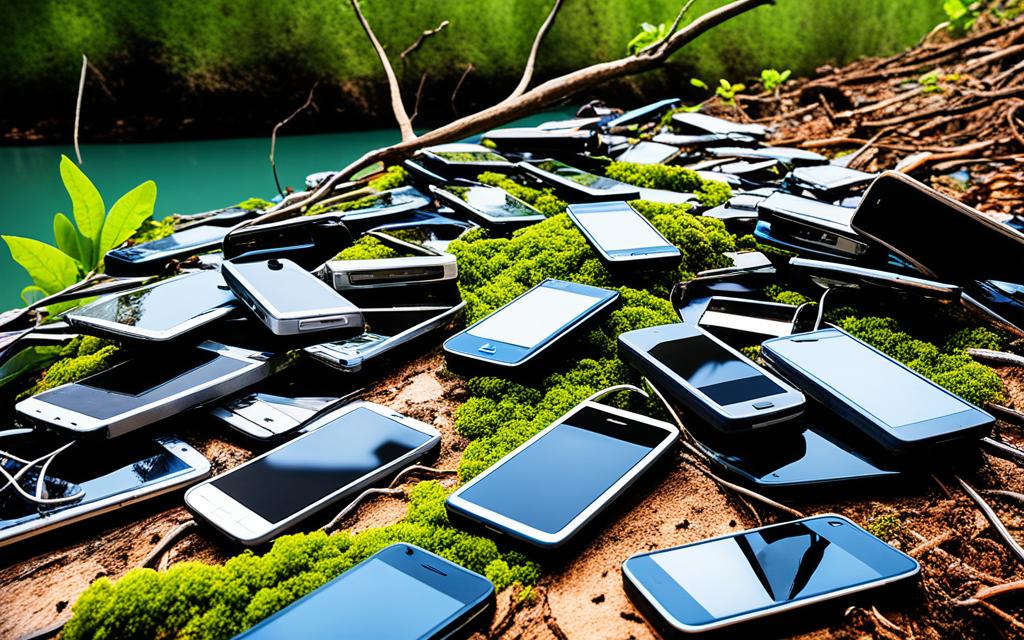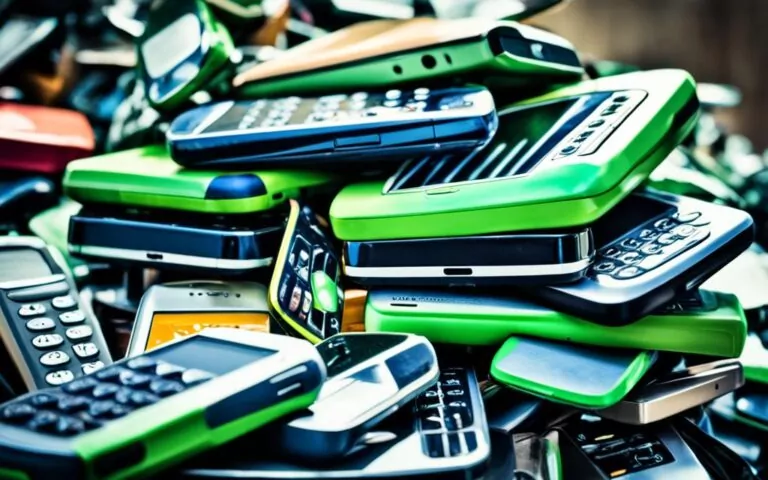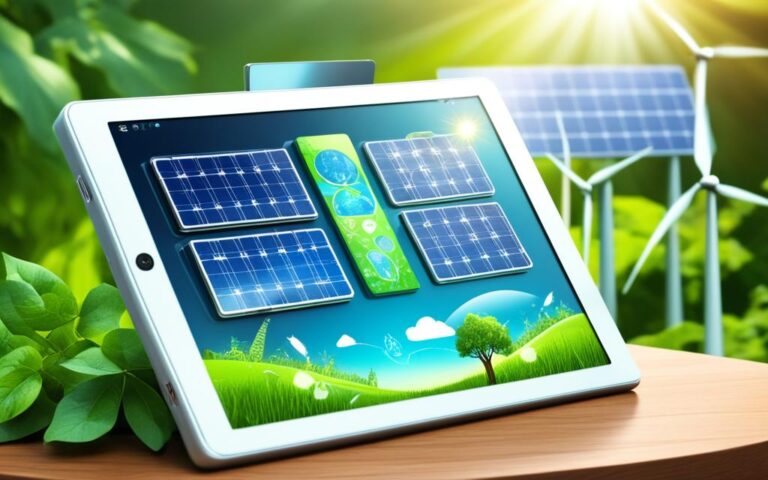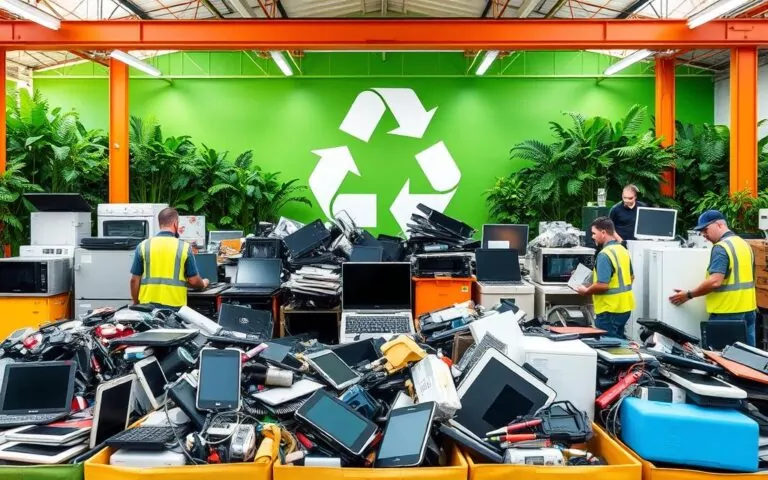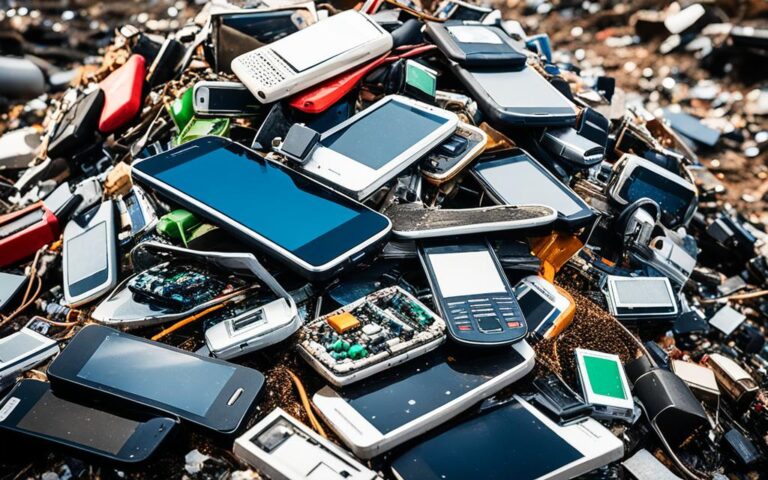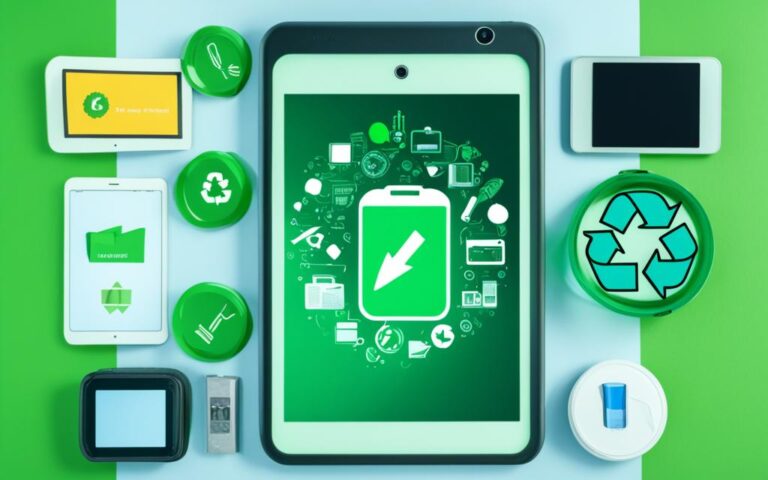The Environmental Impact of Mobile Phone Waste
In today’s digitally connected world, mobile phones have become an indispensable part of our lives. However, what many people may not realize is the significant environmental impact caused by the production and disposal of these devices. The mass production of smartphones not only contributes to environmental pollution but also results in a substantial carbon footprint. This article delves into the environmental consequences of mobile phone waste and explores potential solutions to mitigate its effects.
Smartphone manufacturing is responsible for 85% of a device’s carbon footprint. This carbon emissions primarily stem from metal extraction and production processes. Metal mining activities, particularly for minerals such as gold and copper, have detrimental effects on the environment, including deforestation, water pollution, and the release of eco-toxic elements. The extraction and processing of these metals generate heat and impact local communities residing near the mining facilities.
Moreover, the disposal of mobile phones poses another environmental challenge. Every year, a significant amount of e-waste is generated, with a dismal recycling rate of less than 16%. E-waste contains toxic chemicals such as arsenic, lead, mercury, and brominated flame-retardants, which can pollute the environment and harm both human and planetary health. The linear and throwaway culture surrounding smartphones, where users frequently upgrade their devices before their lifespan ends, exacerbates this problem.
However, amidst these environmental concerns, there is a glimmer of hope. The rising market for refurbished phones and the emergence of eco brands that prioritize sustainability offer potential solutions to reduce the environmental impact of mobile phone waste. By opting for refurbished devices and supporting companies that produce smartphones with minimal environmental footprints, consumers can make a positive difference.
Furthermore, the need for effective phone recycling and a circular economy is paramount. Recycling materials from old phones not only reduces the demand for newly mined minerals but also helps recover valuable components like copper, gold, silver, lithium, and cobalt. Companies such as Fairphone and initiatives promoting a circular economy are spearheading efforts to create smartphones with a minimal environmental impact while taking fair treatment of workers into account.
It is crucial for both manufacturers and consumers to prioritize sustainability and adopt more environmentally friendly practices in the smartphone industry. Through collective action, government regulations, and increased public awareness, we can pave the way towards a more sustainable future, where mobile phone waste is minimized, and our planet is protected for future generations.
The Carbon Footprint of Smartphone Manufacturing
The manufacturing process of smartphones contributes significantly to their carbon footprint, making them one of the most damaging devices to the environment. In fact, the manufacturing phase alone is responsible for 85% of a smartphone’s carbon emissions. These emissions primarily arise from metal extraction, shipping, and production.
Smartphones are made using a variety of chemicals and materials, including silicone, plastic, iron, aluminum, and copper. The extraction of these metals generates substantial solid and liquid waste, often containing eco-toxic elements like arsenic, cadmium, and lead. Furthermore, mining activities for these metals contribute to deforestation and have negative impacts on the landscape.
Smartphone factories, often located in vulnerable areas, also generate heat and contribute to climate change. The energy-intensive manufacturing processes and transportation involved in producing smartphones result in significant carbon emissions that further contribute to the device’s carbon footprint.
To illustrate the scale of the carbon footprint from smartphone manufacturing, see the following table:
| Carbon Footprint Contributors | Percentage Contribution |
|---|---|
| Metal extraction | 40% |
| Shipping | 25% |
| Production | 20% |
| Other processes | 15% |
As the table demonstrates, metal extraction is the largest contributor to a smartphone’s carbon footprint, accounting for 40% of emissions. Shipping and production also play significant roles, each contributing 25% and 20% respectively.
Impact on the Environment
The carbon emissions resulting from smartphone manufacturing not only contribute to climate change but also have other environmental consequences. Metal extraction through mining activities leads to deforestation, disrupting ecosystems and habitats. The release of eco-toxic elements from mining waste can contaminate soil and water, posing risks to the environment and human health.
Furthermore, the energy-intensive manufacturing processes and the disposal of electronic waste, which will be discussed in Section 4, contribute to the overall environmental impact of smartphone manufacturing. It is crucial for both manufacturers and consumers to recognize the magnitude of the carbon footprint and take steps towards more sustainable practices.
Environmental Impacts of Metal Mining
Metal mining activities have a multitude of detrimental effects on the environment, with significant consequences globally. From deforestation to contamination of water sources, the extraction of metals used in smartphone production leaves a lasting imprint on our planet. Let’s explore some of the key environmental impacts associated with metal mining.
1. Deforestation
One major consequence of metal mining, particularly in regions like Brazil, is deforestation. The pursuit of gold, a crucial component in smartphone manufacturing, often leads to the clearing of vast tracts of land, resulting in the destruction of precious ecosystems and habitats for wildlife.
2. Water Contamination
In countries such as Chile and Peru, where significant copper mines are located, water bodies can become contaminated due to mining activities. The discharge of chemical pollutants and heavy metals into rivers and streams poses a severe threat to aquatic life, disrupting sensitive ecosystems and affecting fishing and agricultural industries.
3. Impact on Indigenous Communities
The extraction of metals can unfortunately lead to violence and conflicts in regions where indigenous communities reside. In Brazil, for example, indigenous people often face displacement, loss of livelihoods, and human rights violations as metal mining operations encroach upon their ancestral lands.
| Environmental Impacts of Metal Mining | Consequences |
|---|---|
| Deforestation | Loss of ecosystems and wildlife habitats |
| Water Contamination | Disruption of aquatic ecosystems and impact on fishing/agricultural industries |
| Impact on Indigenous Communities | Violence, displacement, and human rights violations |
Metal mining continues unabated, often occurring in close proximity to protected areas and regions already suffering from water scarcity. The consequences of mining extraction extend beyond immediate environmental damage, with long-term effects that can persist for years to come.
“The extraction of metals for smartphone production places a heavy burden on the environment, resulting in deforestation, water contamination, and social injustices. It is imperative that we find sustainable alternatives and raise awareness of the environmental toll associated with metal mining.” – Environmental activist
E-Waste and the Problem of Phone Disposal
The disposal of mobile phones poses a significant environmental problem. A large amount of e-waste is generated each year, with less than 16% of it being recycled. E-waste, which includes discarded electronic devices like smartphones, contains toxic chemicals like arsenic, lead, mercury, and brominated flame-retardants. These hazardous substances can pollute the environment and pose a threat to human and planetary health.
The plastic housing and components in phones also contribute to microplastic pollution, further exacerbating the impact on ecosystems. Additionally, the linear and throwaway culture surrounding smartphones, with people upgrading their devices before their lifespan ends, leads to avoidable waste and the squandering of precious resources. This wasteful cycle not only harms the environment but also undermines efforts towards sustainability.
It is essential for both manufacturers and consumers to address this issue and strive for more sustainable and less environmentally harmful practices. Manufacturers should prioritize designing smartphones that are more durable, repairable, and easier to recycle. They should also implement responsible e-waste management systems to ensure proper disposal and recycling of devices.
“The disposal of mobile phones and their toxic components can have a lasting impact on our environment and health. It is our collective responsibility to adopt more sustainable practices and find innovative solutions to tackle the growing problem of e-waste.” – Environmentalist Jane Smith
The Importance of Proper Phone Disposal
Proper phone disposal is crucial to minimize the negative environmental impact of e-waste. Recycling old phones allows for the recovery of valuable materials, such as copper, gold, silver, lithium, and cobalt, which can be reused in the production of new devices. Recycling also helps reduce the demand for new mining activities, which often have damaging consequences for the environment.
To ensure this, consumers play a vital role in responsibly disposing of their phones. They can donate or sell functioning devices, or make use of established recycling programs that accept old phones. By embracing the concept of a circular economy, where resources are conserved and reused, we can significantly reduce the environmental impact associated with phone disposal.
The Rising Importance of E-Waste Legislation
E-waste legislation is crucial in addressing the growing problem of phone disposal. Governments around the world need to enact and enforce regulations that require proper e-waste management and recycling. This includes establishing collection points, implementing extended producer responsibility schemes, and promoting public awareness about the importance of responsible phone disposal.
Some countries have already taken steps towards this. For example, the European Union has implemented the Waste Electrical and Electronic Equipment (WEEE) Directive, which sets guidelines for the collection and recycling of electronic waste. Other regions should follow suit and adopt similar measures to ensure the sustainable management of e-waste.
By recognizing the environmental impact of e-waste and implementing sound waste management practices, we can work towards creating a more sustainable future for both the smartphone industry and our planet.
The Need for Phone Recycling and Circular Economy
The recycling of phone materials plays a crucial role in reducing the environmental impact of smartphones. By recycling old phones instead of sending them to landfill sites or contributing to e-waste, we can help minimize the negative consequences.
Successful smartphone dismantling is key to recovering valuable components such as copper, gold, silver, lithium, and cobalt. These materials can then be reused, reducing the need for further extraction and reducing the carbon footprint of future devices.
Companies like Fairphone and initiatives promoting a circular economy are leading the way in producing smartphones with minimal environmental impact. They prioritize sustainability throughout the production process and ensure fair treatment of workers.
“The circular economy is about reusing and recycling resources, rather than consuming and disposing of them. By adopting this approach, we can create a more sustainable future for the smartphone industry and reduce the environmental burden it places on our planet.” – Katherine Dent, Head of Sustainability, Fairphone
The global interest in moving towards a circular economy is growing, which is expected to result in higher rates of refurbished smartphones and increased recycling efforts. This shift will play a significant role in reducing the environmental impact of phone waste.
Benefits of Phone Recycling and Circular Economy
- Reduces the need for raw material extraction and associated environmental damage
- Minimizes e-waste and the release of toxic chemicals into the environment
- Conserves valuable resources by recovering and reusing materials from old phones
- Promotes a more sustainable and ethical approach to smartphone production
- Supports job creation and economic growth in the recycling industry
By embracing phone recycling and a circular economy, we can make a positive impact on the environment and work towards a more sustainable future. It is a collective effort that requires collaboration between consumers, manufacturers, and policymakers to ensure a greener and healthier planet for generations to come.
The Path Towards Sustainability in the Smartphone Industry
The smartphone industry is gradually embracing sustainability, recognizing the urgent need to address the environmental challenges posed by mobile phone waste. In an effort to reduce their carbon footprint, companies like Apple have made commitments to utilize renewable energy in their operations and have started incorporating recycled materials in their devices.
Market indicators reveal a growing trend towards higher durability of smartphones, longer software support, and higher costs of brand new devices. These factors encourage consumers to extend the lifespan of their phones, reducing e-waste and resource consumption. Furthermore, modular smartphones that are easily repairable and upgradable are gaining popularity, enabling users to replace specific components instead of discarding the entire device.
However, achieving sustainability in the smartphone industry is not solely the responsibility of individual companies and consumers. Government regulations play a crucial role in driving industry-wide change. By implementing policies that promote eco-friendly practices and incentivizing sustainable production and disposal methods, governments can create a supportive framework for sustainable smartphone development.
“Government regulations and greater public awareness of environmental practices in the smartphone industry are necessary to drive further change and create a more sustainable future.”
Public awareness and advocacy
Greater public awareness of the environmental impacts of the smartphone industry is vital in fostering a collective sense of responsibility towards sustainability. Education campaigns, environmental organizations, and consumer advocacy groups can play a significant role in raising awareness about the importance of choosing sustainable smartphones, recycling e-waste, and supporting eco-friendly initiatives.
The role of a circular economy
Transitioning to a circular economy model is crucial for achieving long-term sustainability in the smartphone industry. By prioritizing the recovery and reuse of materials, manufacturers can minimize resource depletion, reduce waste generation, and lower carbon emissions. This approach involves designing smartphones with easily recyclable components, establishing effective collection and recycling systems, and encouraging consumers to participate in recycling programs.
| Advantages of a Circular Economy in the Smartphone Industry | Challenges for Implementing a Circular Economy in the Smartphone Industry |
|---|---|
|
|
Implementing a circular economy model in the smartphone industry requires collaboration among manufacturers, consumers, recycling facilities, and regulatory bodies. It necessitates the development of efficient recycling infrastructure, innovative recycling technologies, and the establishment of global standards for sustainable production and disposal.
Embracing sustainability in the smartphone industry is not only an environmental imperative but also a pathway towards building a more sustainable future. By adopting renewable energy, incorporating recycled materials, extending the lifespan of devices, and transitioning to a circular economy, the smartphone industry can significantly reduce its environmental impact and contribute to a more sustainable and greener planet.
Conclusion
The production and disposal of mobile phones have a significant environmental impact on our planet. From carbon emissions and pollution caused by metal mining to the generation of toxic e-waste, the negative consequences are undeniable. However, there is a glimmer of hope in the form of the growing market for refurbished phones and eco brands that prioritize sustainability.
In order to reduce the environmental footprint of the smartphone industry, better recycling practices and a shift towards a circular economy are imperative. The responsible disposal and recycling of mobile phones can help recover valuable materials and minimize the release of toxins into the environment. Companies like Fairphone and initiatives promoting a circular economy are leading the way, producing smartphones with minimal environmental impact and fair treatment of workers.
However, real change requires collective action. Consumer behavior and awareness, along with government regulations and industry initiatives, play a vital role in mitigating the environmental impact of mobile phone waste. It is up to all of us to take action and adopt more sustainable practices. By making conscious choices and supporting environmentally-friendly brands, we can protect our planet for future generations.
FAQ
What is the environmental impact of mobile phone waste?
The environmental impact of mobile phone waste includes carbon emissions, pollution from metal mining, and the generation of toxic e-waste.
What is the carbon footprint of smartphone manufacturing?
The manufacturing process of smartphones accounts for 85% of their carbon footprint, making them the most damaging devices to the environment.
What are the environmental impacts of metal mining?
Metal mining activities contribute to deforestation, water contamination, and negative impacts on ecosystems, with mining for gold and copper being particularly harmful.
What is the problem with phone disposal and e-waste?
The disposal of mobile phones generates a significant amount of e-waste, containing toxic chemicals that can pollute the environment and harm human and planetary health.
What is the need for phone recycling and a circular economy?
Phone recycling plays a crucial role in reducing the environmental impact of smartphones, ensuring valuable components are recovered, and a circular economy minimizes waste.
How is the smartphone industry working towards sustainability?
The smartphone industry is gradually moving towards sustainability with companies incorporating recycled materials, using renewable energy, and producing more durable and repairable devices.
What can be done to address the environmental impact of mobile phone waste?
Consumer behavior, government regulations, and industry initiatives are essential in driving change and adopting more sustainable practices to reduce the environmental impact of mobile phone waste.

